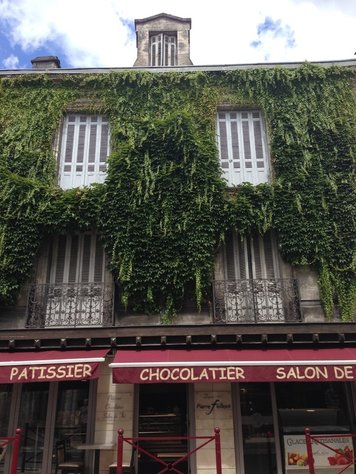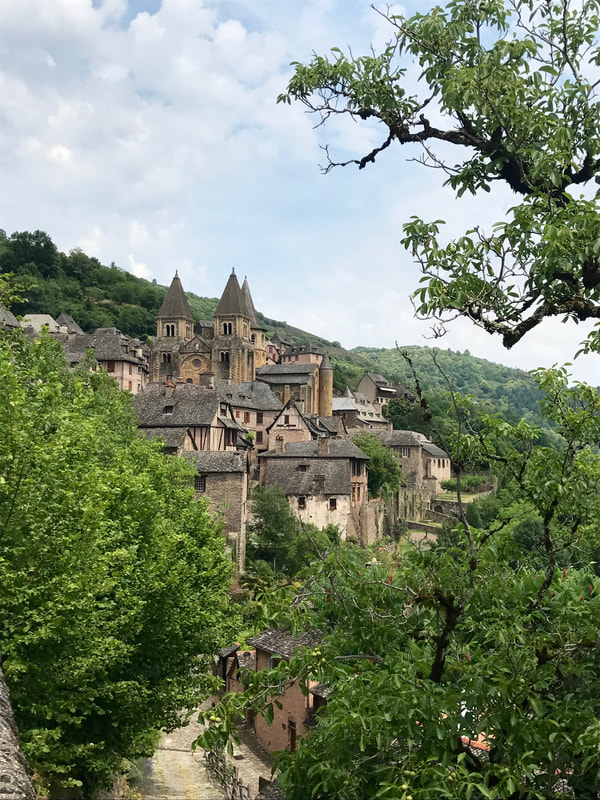|
Time to publish this blog. I started writing this last year, in July, after completing a little road trip to the south of the Charente, Dordogne, completed by a little foray into the Aveyron. Two nights away, based in the town of Sarlat - what a great slice of France to witness and enjoy! Highly recommended, five stars!!
across three days - it was a breeze (we could easily do that in one day in Australia to get to and from towns, so this was a dream)! On Friday we decided to leave Verteuil in the northern part of the Charente département and explore areas to the south and east. It was a time to revisit some of our favourite places that we have previously visited - a time to consolidate in our memory these sights prior to adventuring into the many other unknown and unfamiliar parts of France. Verteuil-sur-Charente to Aubeterre-sur-Dronne (91km, 1hr 11min) Just 50 km south of Angoulême is Aubeterre-sur-Dronne. Famous for its ancient subterranean church, it is a lovely village to wander around and to look through the shops. Owner of the "Plus Beaux Villages de France" brand since 1993 and the label "Petites Cités de Caractère" since 2012, the village has welcomed pilgrims and visitors for more than a thousand years. We picked up two small jars of confit de pineau to try, thinking that if it tasted good, we would gladly add it to our obsession with confiture de lait, another spread, similar to condensed milk that had been recommended to us over here. Aubeterre-sur-Dronne joins the many villages in this part of France that are on a route of the Chemin de St Jaques as the pilgrimage paths wander their ways down through France to funnel into northern Spain through the Pyrénées, on the journey to Santiago de Compostela in north-west Spain. Pilgrim signs marked various walls of village houses. The centuries-old pilgrimage was to become a common theme over the next couple of days. Aubeterre-sur-Dronne to Brantôme (56km, 52min) Another 50 km to the east is Brantôme, a beautiful riverside village on the Dronne river in the north of the department of the Dordogne. Brantôme is always on our list of places to visit and we have been here 4 or 5 times - it never fails to impress. The town has a beautiful mixture of medieval and renaissance architecture to admire. The Benedictine abbey on the banks of the river is superb and the old stone bridge and the beautiful mill have been transformed into a hotel and restaurant. The abbey was originally built by Charlemagne in 769 and there is a troglodytic section behind the abbey built into the cliffs. We managed to make a reservation at the restaurant, Le Moulin de L'Abbeye, which unbeknown to us, earnt a Michelin star in February this year. A great way to celebrate the birthdays of two in our group. We enjoyed a great meal on the mill terrace with attentive service and food that was a visual treat, all the while watching the ducks and ducklings on the river and the canoes riding down the shuttes of the weir, on their way down the river. Brantôme to Périgueux (24km, 26 min) A short drive south to Périgueux. We have only ever driven through this city on the way to the Dordogne valley. Don has always wanted to stop off at the imposing cathredal that can be seen on the skyline. We braved peak hour traffic to find a spot to park and have a look at the Saint Front cathedral. This regional centre promises to be a future destination in itself - lots of roman ruins and a great looking old city centre. Périgueux to Sarlat (70km, 1hr 10min) Sarlat-la-Canéda is a must-visit town. The market town of Sarlat is reknown for its foie gras - you'll see images of ducks and geese everywhere! It's a special, lovely old town, and the spring-board for one of the "special" regions of France - the Dordogne valley. It has been relatively untouched in recent centuries and as a result, Sarlat has remained preserved and one of the towns most representative of 14th century France. Try to arrange your visit to include Saturday, as it has a fantastic market on Saturdays mornings. From Sarlat it is easy to visit Les Eyzies and visit the National Prehistoric Museum. The local area is sprinkled with caves with evidence of their prehistoric dwellers. Lascaux offers cave paintings over 17 000 years old! The highight is a drive along the Dordogne river visiting some of the cliff top châteaux of Beynac et Cazenac, Castelnaud and La Rocque to name a few. An absolute must. Sarlat to Domme (return trip 12km, 18 min each way) Domme is well worth a visit and offers beautiful views up and down the Dordogne valley and river. It lies high on a rocky outcrop overlooking the Dordogne river and is a bastide, or fortified medieval town. Today, Domme is a member of the association Les Plus Beaux Villages de France ("The Most Beautiful Villages of France"). Domme was founded in 1281 and has a turbulent history. In 1307, the Knight Templars were imprisoned in Domme during the trial against them. During the Hundred Years' War, the bastide was coveted by the English who first took the town in 1347 and repeatedly changed rulers throughout the war until 1437 when it finally fell under French rule again. The Wars of Religion brought new turmoil. Protestants took the city in 1588 by climbing the cliffs at night to open the gates. Apparently this was a short success, as the Protestants handed the bastide back to the Catholics in 1592. Domme is a great town to wander around, take in the views and do some shopping. Sarlat to Conques (131km, 2hrs 11min) We were first motivated to visit Conques in 2014 after seeing some beautiful photos of the village in a cook book we have at home - A Food Lovers' Pilgrimage to Santiago de Compostela. We were spending a week R and R in the south after our 780km walk along the camino and took the opportunity to visit while driving back to Verteuil. A further incentive was that it was a well known pilgrim stop-over for those travelling along one of the French pilgrim routes on their way south west toward Spain. After our visit, we were hooked! The village built on a hillside and has classic narrow medieval streets. As a result, large vehicles such as buses cannot enter the historic town centre but must park outside. Consequently, most day visitors enter on foot. The town was largely passed by in the nineteenth century due to its location. As a result, the historic core of the town has very little construction dating from between 1800 and 1950, leaving the medieval structures remarkably intact. It has a woderful charm and is in an idyllic location, buried in the mountains of the Aveyron. The Abbey Church of Saint Foy in Conques was a popular stop for pilgrims on the camino de Santiago. The main draw for medieval pilgrims at Conques were the remains of Saint Faith ("St. Foy"), a martyred young woman from the fourth century. The original monastery building at Conques was an eighth-century oratory built by monks fleeing the Saracens in Spain. The relics of St. Foy were brought to Conques in the 11th century and caused the pilgrimage route to shift from Agen to Conques. The Abbey Church of Saint Foy was added to the UNESCO World Heritage Sites in 1998, as part of the World Heritage Sites of the Routes of Santiago de Compostela in France. Conques to Rocamadour (89km, 1hr 35min) Flights of steps ascend from the lower town to the churches, a group of massive buildings half-way up the cliff. The chief of them is the pilgrimage church of Notre Dame, containing a wooden Black Madonna reputed to have been carved by Saint Amator (Amadour).
1 Comment
|
|



























 RSS Feed
RSS Feed